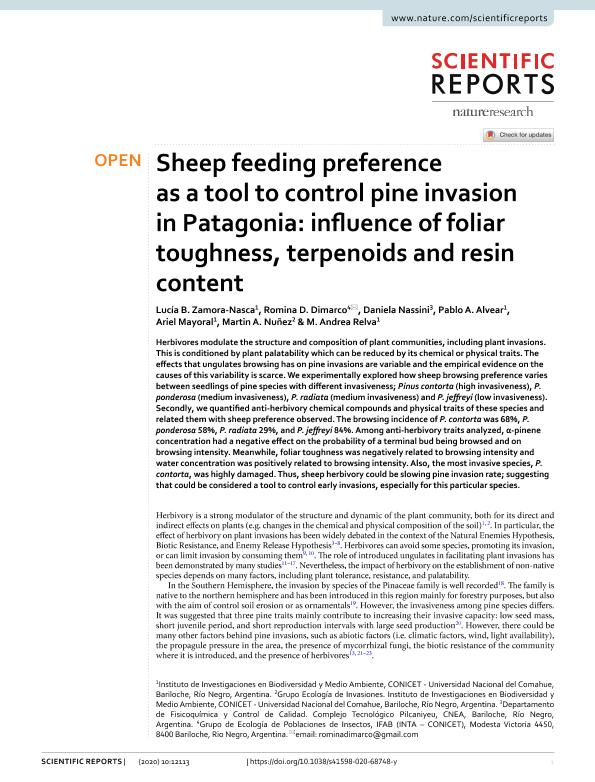Artículo
Sheep feeding preference as a tool to control pine invasion in Patagonia: influence of foliar toughness, terpenoids and resin content
Zamora Nasca, Lucía Belén ; Dimarco, Romina Daniela
; Dimarco, Romina Daniela ; Nassini, Daniela
; Nassini, Daniela ; Alvear, Pablo Andres
; Alvear, Pablo Andres ; Mayoral, Ariel Alejandro
; Mayoral, Ariel Alejandro ; Nuñez, Martin Andres
; Nuñez, Martin Andres ; Relva, Maria Andrea
; Relva, Maria Andrea
 ; Dimarco, Romina Daniela
; Dimarco, Romina Daniela ; Nassini, Daniela
; Nassini, Daniela ; Alvear, Pablo Andres
; Alvear, Pablo Andres ; Mayoral, Ariel Alejandro
; Mayoral, Ariel Alejandro ; Nuñez, Martin Andres
; Nuñez, Martin Andres ; Relva, Maria Andrea
; Relva, Maria Andrea
Fecha de publicación:
07/2020
Editorial:
Nature
Revista:
Scientific Reports
ISSN:
2045-2322
Idioma:
Inglés
Tipo de recurso:
Artículo publicado
Clasificación temática:
Resumen
Herbivores modulate the structure and composition of plant communities, including plant invasions. This is conditioned by plant palatability which can be reduced by its chemical or physical traits. The effects that ungulates browsing has on pine invasions are variable and the empirical evidence on the causes of this variability is scarce. We experimentally explored how sheep browsing preference varies between seedlings of pine species with different invasiveness; Pinus contorta (high invasiveness), P. ponderosa (medium invasiveness), P. radiata (medium invasiveness) and P. jeffreyi (low invasiveness). Secondly, we quantified anti-herbivory chemical compounds and physical traits of these species and related them with sheep preference observed. The browsing incidence of P. contorta was 68%, P. ponderosa 58%, P. radiata 29%, and P. jeffreyi 84%. Among anti-herbivory traits analyzed, α-pinene concentration had a negative effect on the probability of a terminal bud being browsed and on browsing intensity. Meanwhile, foliar toughness was negatively related to browsing intensity and water concentration was positively related to browsing intensity. Also, the most invasive species, P. contorta, was highly damaged. Thus, sheep herbivory could be slowing pine invasion rate; suggesting that could be considered a tool to control early invasions, especially for this particular species.
Palabras clave:
hervivores
,
invasions
,
preferences
,
pinus
Archivos asociados
Licencia
Identificadores
Colecciones
Articulos (IFAB)
Articulos de INSTITUTO DE INVESTIGACIONES FORESTALES Y AGROPECUARIAS BARILOCHE
Articulos de INSTITUTO DE INVESTIGACIONES FORESTALES Y AGROPECUARIAS BARILOCHE
Articulos(INIBIOMA)
Articulos de INST. DE INVEST.EN BIODIVERSIDAD Y MEDIOAMBIENTE
Articulos de INST. DE INVEST.EN BIODIVERSIDAD Y MEDIOAMBIENTE
Citación
Zamora Nasca, Lucía Belén; Dimarco, Romina Daniela; Nassini, Daniela; Alvear, Pablo Andres; Mayoral, Ariel Alejandro; et al.; Sheep feeding preference as a tool to control pine invasion in Patagonia: influence of foliar toughness, terpenoids and resin content; Nature; Scientific Reports; 10; 1; 7-2020; 1-12
Compartir
Altmétricas



